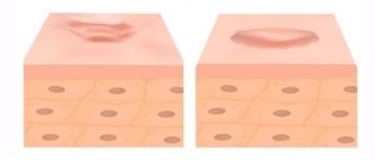Acne
Understanding Acne: What is Acne?
Acne Vulgaris, commonly referred to as Acne, or 'Pimples', is a condition involving hair follicles and their oil producing glands, also known as sebaceous glands. Together they may be referred to as a 'pilosebaceous unit'.
Acne breakouts occur when pilosebaceous units become blocked, and bacteria infiltrate the blocked pore. The bacteria interact with sebum to cause local inflammation, leading to a pimple.
Increased sebum production occurs more in adolescence but also in certain medical conditions.
Pimples may cluster to become nodules or cysts and are more likely to lead to scarring even after the acne has resolved.

Acne Scar Formation
Clogged pore from increased sebum


Bacterial overgrowth causes skin inflammation
Pilosebaceous unit becomes inflammed
Scar type collagen leads to depressed scars
Medical Management of Acne


How do we treat Acne?
Acne has been traditionally treated with a combination of antibiotics and retinoids (Vitamin A derivatives). These are available in topical (Dalacin and Differin) and oral forms (Doxycycline, Minocycline and Roaccutane).
Antibiotics work by reducing acne-causing bacteria. This controls the transformation from comedones (clogged pores) to inflammatory pustules and cysts (pimples).
Retinoids target the pilosebaceous unit to reduce sebum production and reduce inflammation around the pore following bacterial proliferation.
In combination, this is the most scientifically-backed, most widely accepted approach toward controlling active acne.
More recently, there has been a rise in adjuvant non-pharmacological (non-medicated) approaches toward acne care. Energy devices such as Laser treatment, Plasma treatment and selective radiofrequency ablation (AGNES) are becoming more widely accepted as non-drug adjuncts for combined treatment of active acne.
However, these all have one thing in common, and that is that they do not improve existing acne scars.
How do we treat Acne Scars?
We must first control active acne to prevent the formation of new scars before we can focus on the most effective treatment to improve existing scars.
In the first consultation, our doctor will recommend an acne scar treatment programme based on individual skin condition and the type of scars.
Types of Acne Scars
The broad categories of acne scars can be classified as hypotrophic and hypertrophic.
Examples of hypotrophic scars include rolling scars, ice pick scars and boxcar scars. Each scar responds to different scar treatments different. Frequently, a combination of scar treatments must be used to address each type of acne scar.




Hypertrophic scars are thick, raised scars. They form as an abnormal response to wound healing, where extra connective tissue forms around the original wound area. The result is a raised scar. Hypertrophic scars differ in character from hypotrophic scars and keloids and are treated differently.
Hypertrophic scar
Keloid


